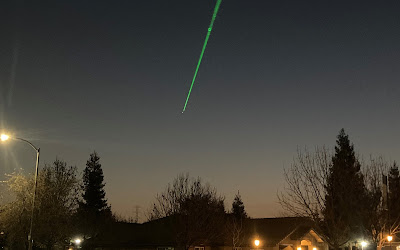Saturn and Jupiter Conjunction 2020
I think everybody agrees that 2020 has
not been a good year. For us, there has
been challenges and more challenges. In
September of this year, we moved to Bakersfield, CA because of the fires in
Boulder Creek. Thankfully, our stuff
survived the fire and my telescope with it. The smoke does not seem to have damaged the
optics, but other than that, my scope smells like BBQ (or used to) everything
else seems all right.
So, I was disappointed with my previous
location because most of the sky was blocked by huge redwoods. Here, we have plenty of sky, but not enough darkness.
The air is also not as clean as in the mountains so transparency has not been
the best. I think this is a Bortle 8/9
zone and there are tons of ambient lights around at night. We rented an
apartment so the whole situation has kept me away from the stars. Fortunately,
the planets don’t need much darkness and since it has been advertised in the
media, I could not miss the chance to check this amazing conjunction of the two
gas giants: Jupiter with its Galilean Moons and Saturn with its rings.
My apartment’s entrance faces the
southwest so I have followed these two for a while. The days and nights here in
the San Joaquin Valley, seem to have few cloud activity so it was a good
setting to enjoy this celestial show. On the 20th, they were so
close that I took the scope out and gave them a try. Quite a view: Jupiter was
exhibiting all its four Galilean moons and because of a background star, it
appeared like there were five. We enjoyed the show for a while, try some
pictures with the phone and called it a day. Today, on the 21st, I wanted to
spot the couple still in daylight so I could take a better picture with my
phone. I just shot at the eyepiece without any adjustments. The problem with
the moon and the planets is that they are so bright, that the picture at the
home looks overexposed. I am not much into Astrophotography so I try my best,
but not with much effort.
At 5:15 local time (GMT -8), just a few
minutes after the sun had set and still in daylight, I spotted the shy dot of
light. It was so dim against the bright background that the phone could not
detect it when I tried to get a picture. I pointed my scope at it and check on the 40mm eyepiece. There
it was: both planets in the vast FOV. Bumping up the magnification to 100, I
could see Jupiter’s bands. I went on to 166x and 332x (with a 2x Barlow), but
the seeing was bad. The planets were boiling in the FOV. My favorite view was
at 100x, with a stable view that could give me enough details on the planets,
but I decided to put up a digital sketch (using the phone picture) for the view
at 166x. Maybe I should not say it is a digital sketch, but a touched up
picture. Lol
Anyways, here it is and so is the
picture I made with my phone of the scene. I could still split up both objects
with just my eyes. They made a wonderful pair to wrap up as a Christmas
present!
Merry Christmas to all,
LG
Edited by: Jennifer Carvajal (editor in chief).





